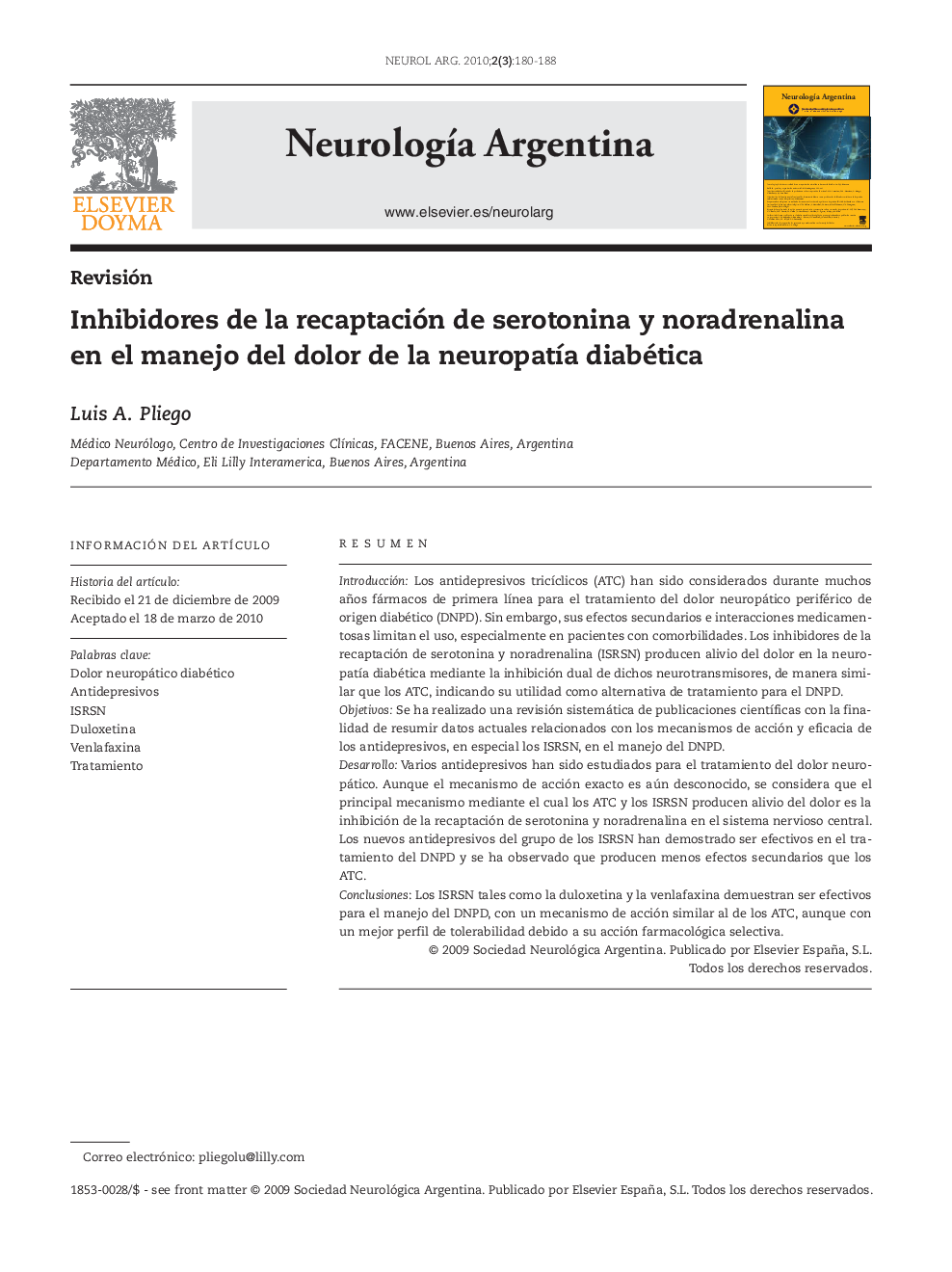| کد مقاله | کد نشریه | سال انتشار | مقاله انگلیسی | نسخه تمام متن |
|---|---|---|---|---|
| 3076856 | 1189106 | 2010 | 9 صفحه PDF | دانلود رایگان |

ResumenIntroducciónLos antidepresivos tricíclicos (ATC) han sido considerados durante muchos años fármacos de primera línea para el tratamiento del dolor neuropático periférico de origen diabético (DNPD). Sin embargo, sus efectos secundarios e interacciones medicamentosas limitan el uso, especialmente en pacientes con comorbilidades. Los inhibidores de la recaptación de serotonina y noradrenalina (ISRSN) producen alivio del dolor en la neuropatía diabética mediante la inhibición dual de dichos neurotransmisores, de manera similar que los ATC, indicando su utilidad como alternativa de tratamiento para el DNPD.ObjetivosSe ha realizado una revisión sistemática de publicaciones científicas con la finalidad de resumir datos actuales relacionados con los mecanismos de acción y eficacia de los antidepresivos, en especial los ISRSN, en el manejo del DNPD.DesarrolloVarios antidepresivos han sido estudiados para el tratamiento del dolor neuropático. Aunque el mecanismo de acción exacto es aún desconocido, se considera que el principal mecanismo mediante el cual los ATC y los ISRSN producen alivio del dolor es la inhibición de la recaptación de serotonina y noradrenalina en el sistema nervioso central. Los nuevos antidepresivos del grupo de los ISRSN han demostrado ser efectivos en el tratamiento del DNPD y se ha observado que producen menos efectos secundarios que los ATC.ConclusionesLos ISRSN tales como la duloxetina y la venlafaxina demuestran ser efectivos para el manejo del DNPD, con un mecanismo de acción similar al de los ATC, aunque con un mejor perfil de tolerabilidad debido a su acción farmacológica selectiva.
IntroductionTricyclic antidepressants (TCAs) have been considered for many years as first-line agents for the symptomatic treatment of diabetic peripheral neuropathic pain (DPNP). However, adverse effects and drug interactions of TCAs limit their use in clinical practice, particularly in patients with comorbidities. Serotonin noradrenaline reuptake inhibitors (SNRIs) produce pain relief of DPNP through dual inhibition of serotonin and noradrenaline reuptake, which is similar to that of the TCAs. It suggests they are likely to be beneficial as an alternative treatment of DPNP.ObjectiveA systematic review of the scientific literature on the treatment of DPNP was conducted in order to summarize current data about the mechanisms and efficacy of antidepressant drugs, particularly SNRIs, in the management of DPNP.DevelopmentMany antidepressants have been investigated in the management of neuropathic pain. Although the precise mechanism of action is still unknown, there have been many significant advances in this area. The main mechanism through which the TCAs and the SNRIs are thought to produce pain relief is inhibition of noradrenaline and serotonin reuptake in the central nervous system. Newer SNRIs antidepressants have demonstrated to be effective in the treatment of DPNP and it has been shown that produce fewer adverse effects than the TCAs.ConclusionsSNRIs such as duloxetine and venlafaxine were shown to be effective for the management of DPNP, with a mechanism of action similar to that of TCAs, although they appeared to have a better tolerability profile due to a selective pharmacological mechanism.
Journal: Neurología Argentina - Volume 2, Issue 3, July–September 2010, Pages 180–188